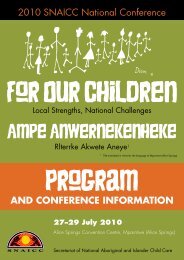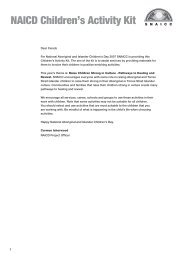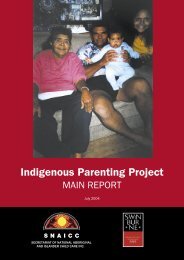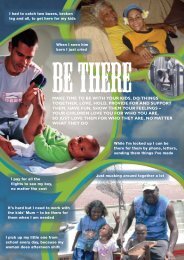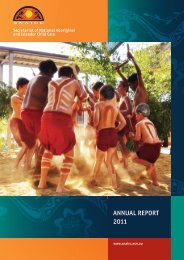Highlights of Research Findings from Abecedarian Studies
Highlights of Research Findings from Abecedarian Studies
Highlights of Research Findings from Abecedarian Studies
You also want an ePaper? Increase the reach of your titles
YUMPU automatically turns print PDFs into web optimized ePapers that Google loves.
The <strong>Abecedarian</strong> Approach<br />
and<br />
<strong>Highlights</strong> <strong>of</strong> <strong>Research</strong> <strong>Findings</strong> <strong>from</strong> <strong>Abecedarian</strong> <strong>Studies</strong><br />
By: Dr Joseph Sparling<br />
The keynote speach by Dr Joseph Sparling to the SNAICC National<br />
Conference Alice Springs was based around the following two papers.<br />
The first , The Abecadarian Approach, is based on the practice; the<br />
second is based around <strong>Highlights</strong> <strong>of</strong> <strong>Research</strong> <strong>Findings</strong>.<br />
Joseph Sparling, PhD, is an early childhood educator and<br />
former teacher and principal, is <strong>Research</strong> Pr<strong>of</strong>essor at Georgetown<br />
University, Fellow <strong>of</strong> the Frank Porter Child Development Institute<br />
<strong>of</strong> the University <strong>of</strong> North Carolina at Chapel Hill, and the first<br />
author <strong>of</strong> LearningGames®, Partners for Learning, and Conversation<br />
Books, educational resources that have been used widely in the<br />
United States. He has also developed curriculum and provided<br />
training and intervention services for orphanages in Romania.<br />
Sparling was a co-principal investigator on the <strong>Abecedarian</strong><br />
studies, three longitudinal research projects conducted over 30 years<br />
with at-risk children. Through this research, he demonstrated the<br />
efficacy <strong>of</strong> early childhood education by developing simple tools<br />
that doubled children’s learning capacity and improved their health,<br />
social emotional well-being, employment and other life outcomes.<br />
His landmark Carolina <strong>Abecedarian</strong> project was a combined<br />
The <strong>Abecedarian</strong> Approach<br />
The <strong>Abecedarian</strong> Approach is a suite<br />
<strong>of</strong> teaching and learning strategies<br />
that were developed for and tested<br />
in the <strong>Abecedarian</strong> <strong>Studies</strong>, three<br />
longitudinal investigations to test the<br />
power <strong>of</strong> high quality early childhood<br />
services to improve the later academic<br />
achievement <strong>of</strong> children <strong>from</strong> at-risk<br />
and under-resourced families. The<br />
long term positive results <strong>of</strong> these<br />
randomised, controlled trials are now<br />
known throughout the world and<br />
form a major part <strong>of</strong> the evidence<br />
that supports our current belief in<br />
the efficacy <strong>of</strong> high quality early<br />
childhood programs.<br />
The <strong>Abecedarian</strong> Approach is<br />
comprised <strong>of</strong> these elements:<br />
early intervention for children <strong>of</strong> poor and minority families with<br />
child care and used an experimental design project involving<br />
experiment and comparison groups. Results indicated that by<br />
the age <strong>of</strong> eight, children who received preschool intervention<br />
subsequently performed better academically than those who<br />
had no preschool experience. Benefits were gained regardless <strong>of</strong><br />
disadvantage, family factors and other contextual issues.<br />
In mid-2010, Sparling was an academic visitor for two months<br />
at the University <strong>of</strong> Melbourne, where he conducted research into<br />
the potential implementation <strong>of</strong> the <strong>Abecedarian</strong> Approach in<br />
Australia (titled ‘the 3A concept’). His visit raised interest regarding<br />
the applicability <strong>of</strong> the 3A concept to Aboriginal and Torres Strait<br />
Islander children and famiies.<br />
Sparling is currently on a study trip in Australia with the<br />
support <strong>of</strong> SNAICC to consult further on the 3A concept with<br />
relevant government, community and Aboriginal and Torres Strait<br />
Islander representatives.<br />
A recorded interview with Melbourne Graduate School <strong>of</strong><br />
Education can be heard at wwww.snaicc.asn.au/policy/conference or at<br />
http://upclose.unimelb.edu.au/episode/285.<br />
The <strong>Abecedarian</strong> elements can be<br />
used in classrooms, family day care,<br />
parent groups, and home visits – and<br />
can provide a link between these service<br />
components. In the <strong>Abecedarian</strong> <strong>Studies</strong>,<br />
these elements were used in long day care<br />
combined with home visits and/or parent<br />
groups.<br />
LearningGames.<br />
LearningGames is a set <strong>of</strong> 200<br />
individualized, game-like activities that<br />
are shared between an adult and 1 or 2<br />
children. Each child experiences at least<br />
1 or 2 LearningGames episodes per day.<br />
They include many items that are familiar<br />
to parents and teachers. They are based on<br />
the concepts <strong>of</strong> Vygotsky and Piaget and<br />
can be thought <strong>of</strong> as “bite-size pieces <strong>of</strong><br />
curriculum.”<br />
SNAICC: Secretariat <strong>of</strong> National Aboriginal and Islander Child Care Inc.<br />
The national peak body for Aboriginal and Torres Strait Islander child and family services in Australia<br />
PO Box 1445 North Fitzroy Victoria, Australia 3068 Ph: 03 9489 8099 www.snaicc.asn.au
Article 1: The <strong>Abecedarian</strong> approach<br />
There are 3 types <strong>of</strong> games:<br />
• Games that are seamlessly integrated into<br />
the routines <strong>of</strong> caregiving<br />
• Games in which the adult joins and<br />
enriches in-progress child play<br />
• Games in which the adult initiates an<br />
interaction, inviting the child to join in.<br />
These are basic principles <strong>of</strong><br />
LearningGames:<br />
• Simple but deep<br />
• Focuses on adult-child interaction<br />
(mainly 1-on-1 interactions & some<br />
small group experiences)<br />
• Made up <strong>of</strong> individual items (pages) that<br />
teachers can use but can also be given to<br />
parents – parents and teachers use the<br />
same materials<br />
• Flexible – used in different types <strong>of</strong><br />
programs (including day care and home<br />
visiting).<br />
Conversational reading<br />
The second element <strong>of</strong> the <strong>Abecedarian</strong><br />
Approach is modelled on the way parents<br />
and children read together rather than<br />
the way reading typically occurs in the<br />
classroom. Conversational reading is based<br />
on the concept <strong>of</strong> “joint attention.” In the<br />
<strong>Abecedarian</strong> Approach every child (age 0-3)<br />
is read to individually each day, and pairs <strong>of</strong><br />
children ages 3-4 are read to each day.<br />
These are basic principles <strong>of</strong><br />
Conversational Reading:<br />
• The 3 S’s are used as stair steps, each a<br />
little more advanced that the last<br />
• Can be used by both educators and parents.<br />
Language Priority<br />
In the third element <strong>of</strong> the <strong>Abecedarian</strong><br />
Approach, educators and parents emphasise<br />
language throughout the day. They respond<br />
warmly whenever children make an attempt<br />
to “talk” to them. They try to create longer<br />
“conversations” with individual children.<br />
The 3N Strategy (notice, nudge, narrate) is<br />
used to turn any event into an occasion for<br />
rich language stimulation.<br />
These are basic principles <strong>of</strong><br />
Language Priority:<br />
• Emphasise language in every event <strong>of</strong><br />
the day<br />
• Respond to children’s language overtures<br />
• Extend “conversations” so that they<br />
include several turns on the same topic<br />
(extended discourse)<br />
• Use a strategy (e.g., 3N) for surrounding<br />
spontaneous events with adult language<br />
• Share language priority techniques and<br />
explain the importance <strong>of</strong> language with<br />
the child’s family.<br />
own preferences, abilities, and life situation.<br />
Further, care frequently can be enriched<br />
with educational content.<br />
By highlighting the pivotal role <strong>of</strong> care<br />
in the education <strong>of</strong> young children, the<br />
<strong>Abecedarian</strong> approach imbues all <strong>of</strong> the<br />
child’s day with educational meaning.<br />
Basic principles <strong>of</strong> enriched<br />
caregiving:<br />
• If possible, divide your group so that<br />
each adult has a specific group <strong>of</strong><br />
children she always cares for (or does<br />
most <strong>of</strong> the care for)<br />
• Respond as quickly as possible, do not<br />
wait until the child has cried a lot before<br />
going to him or her<br />
• Take educational advantage <strong>of</strong> the fact<br />
that you are in close physical contact<br />
with the child during most caregiving<br />
routines (speak s<strong>of</strong>tly and directly to the<br />
child, with eye contact)<br />
• Explain the process <strong>of</strong> what you are<br />
doing and name the objects you touch<br />
during care routines (and when the child<br />
is ready, invite the child to take the lead<br />
in naming the caregiving actions and<br />
associated objects)<br />
• Ask questions about what will come next<br />
• Let the child have specific responsibilities<br />
during care routines<br />
• Put some appropriate educational<br />
materials near the scene <strong>of</strong> a caregiving<br />
event<br />
• Think about the educational content<br />
(for example naming colors, textures,<br />
or counting) that might fit into a care<br />
routine – and include it<br />
• Repeat, repeat, repeat.<br />
• Goes back and forth, like a conversation<br />
• Appropriate <strong>from</strong> infancy through age<br />
four (or older)<br />
• Engages one or two children at a time<br />
• Employs an easy and memorable strategy<br />
consisting <strong>of</strong> only three parts (3S is the<br />
memory aid for these three parts)<br />
Enriched caregiving<br />
The <strong>Abecedarian</strong> curriculum approach<br />
affirms that, in the first five years <strong>of</strong> life,<br />
education and caregiving cannot and<br />
should not be thought <strong>of</strong> as distinctly<br />
different activities. The phrase “enriched<br />
caregiving” is intended to remind all <strong>of</strong> us<br />
(researchers, parents, caregivers, teachers,<br />
and program administrators) that “care” for<br />
an infant or young child can and should do<br />
several things at once.<br />
Care can meet the vital needs that<br />
support life and stimulate growth while also<br />
being responsive to the individual child’s<br />
End article 1: The <strong>Abecedarian</strong> Approach<br />
2 SNAICC National Conference Alice Springs 2010 www.snaicc.asn.au/policy/conf
Article 2: <strong>Highlights</strong> <strong>of</strong> research <strong>from</strong> the <strong>Abecedarian</strong> studies<br />
<strong>Highlights</strong> <strong>of</strong> <strong>Research</strong> <strong>Findings</strong> <strong>from</strong> the <strong>Abecedarian</strong> <strong>Studies</strong><br />
Joseph Sparling, Ph.D.<br />
Center on Health and Education, Georgetown University, FPG Child Development Institute, University <strong>of</strong> North Carolina at Chapel Hill<br />
Teaching Strategies, Inc.. www.teachingStrategies.coT<br />
A series <strong>of</strong> randomised controlled trials (RCT’s) called “the <strong>Abecedarian</strong><br />
studies” demonstrate the significant benefits <strong>of</strong> high-quality early<br />
childhood education for poor and at-risk children and their families.<br />
Children in the studies included those at risk <strong>from</strong> multiple social<br />
conditions such as poverty, young maternal age, or low parental education.<br />
Other children in two orphanage studies were at risk because <strong>of</strong> parental<br />
abandonment. Importantly, children in some <strong>of</strong> the studies came <strong>from</strong><br />
a wide range <strong>of</strong> social classes. Many <strong>of</strong> these children had no additional<br />
risk other than being born at low birth weight or with cerebral palsy.<br />
Each <strong>Abecedarian</strong> study used LearningGames® as a core component <strong>of</strong> the<br />
educational program delivered through center and/or home intervention.<br />
<strong>Abecedarian</strong> Study 1 began in 1972, and follow-up data were collected<br />
through 2009. These are the RTC’s:<br />
Keynote background papers: Dr Joseph Sparling 3
<strong>Highlights</strong> <strong>of</strong> <strong>Research</strong> <strong>Findings</strong> <strong>from</strong> the <strong>Abecedarian</strong> <strong>Studies</strong><br />
What were some <strong>of</strong> the outcomes for participants in<br />
these scientific investigations?<br />
The following paragraphs and figures highlight some key findings, first in<br />
the early years <strong>of</strong> life, then in the middle and adolescent years, and then in<br />
the young adult years. Finally, findings are presented for the parents <strong>of</strong> the<br />
children who were enrolled in the <strong>Abecedarian</strong> program.<br />
intervention group in the 2000–2500 grams birth weight range had these<br />
characteristics:<br />
• higher math achievement<br />
• higher receptive vocabulary<br />
• fewer risk taking behaviors (McCormick et al., 2006).<br />
These long term, positive findings are particularly encouraging because<br />
they were achieved in a program that lasted <strong>from</strong> birth to 36 months <strong>of</strong><br />
age rather than <strong>from</strong> birth to 60 months <strong>of</strong> age as in <strong>Abecedarian</strong> <strong>Studies</strong><br />
1 and 2. They underscore the importance <strong>of</strong> the first 3 years <strong>of</strong> life. www.<br />
TeachingStrategies.com Toll Free: 1.800.637.3652<br />
Percentage <strong>of</strong> young adults in a skilled job or higher<br />
education<br />
At age 21, almost 70% <strong>of</strong> the young adults who had received the<br />
<strong>Abecedarian</strong> intervention in the infancy and preschool years were<br />
attending a 4 year college or were employed in a skilled job (such as an<br />
electrician or higher), compared to about 40% <strong>of</strong> those who did not<br />
receive the preschool intervention (Campbell, Ramey, et al., 2002).<br />
Percentage <strong>of</strong> child sample in normal IQ range (>84) by<br />
age<br />
Almost all <strong>of</strong> the at risk children in both the experimental and control<br />
groups <strong>of</strong> <strong>Abecedarian</strong> Study 1 were in the normal IQ range at the<br />
beginning <strong>of</strong> the study. Most <strong>of</strong> those who received the <strong>Abecedarian</strong><br />
intervention continued to stay in the normal IQ range, while more than<br />
half <strong>of</strong> those who did not receive the intervention fell out <strong>of</strong> the normal<br />
range by 48 months <strong>of</strong> age. This decline is seen in the descending yellow<br />
bars in the accompanying figure (Martin, Ramey, & Ramey, 1990).<br />
Special education placements by age 15<br />
When the at-risk young children entered public school, those who did not<br />
receive the <strong>Abecedarian</strong> enriched educational child care program in the<br />
first 5 years <strong>of</strong> life were more than twice as likely to be placed in special<br />
education for 1 or more years by the time they reached age 15 (Ramey &<br />
Ramey, 1999).<br />
Post High School Education for Teen Mothers <strong>of</strong> Children<br />
Studied<br />
Not only did the children benefit, but benefits accrued for the mothers<br />
<strong>of</strong> the children who received the <strong>Abecedarian</strong> program. In <strong>Abecedarian</strong><br />
Study 1, over a third <strong>of</strong> the parents <strong>of</strong> the infants enrolled were teenagers.<br />
About 80% <strong>of</strong> the teen mothers whose infants received the <strong>Abecedarian</strong><br />
program continued on to get post-secondary education, compared to<br />
about 30% <strong>of</strong> teen mothers whose infants did not receive the <strong>Abecedarian</strong><br />
program. As seen in the red line in the accompanying figure, the teen<br />
mothers continued to get more education for as long as 8 years after their<br />
children entered the program (Ramey et al., 2000,).<br />
Adolescent outcomes for low birth weight babies<br />
What about the results for low birth weight babies who received the<br />
<strong>Abecedarian</strong> program? When the intervention and control groups (pooled<br />
<strong>from</strong> eight sites in <strong>Abecedarian</strong> <strong>Studies</strong> 3-10) were compared at age 18. The<br />
4 SNAICC National Conference Alice Springs 2010 www.snaicc.asn.au/policy/conf
<strong>Highlights</strong> <strong>of</strong> <strong>Research</strong> <strong>Findings</strong> <strong>from</strong> the <strong>Abecedarian</strong> <strong>Studies</strong><br />
Behavior <strong>of</strong> parents who received training in key parts<br />
<strong>of</strong> the <strong>Abecedarian</strong> approach (LearningGames and<br />
Conversational Reading)<br />
In addition to the <strong>Abecedarian</strong> studies, a national study was<br />
commissioned by the U.S. Department <strong>of</strong> Education’s Institute <strong>of</strong><br />
Education Sciences <strong>of</strong> the use <strong>of</strong> some <strong>of</strong> the elements <strong>of</strong> the <strong>Abecedarian</strong><br />
curriculum approach in Even Start programs.<br />
This RCT was conducted in 120 sites across the USA and analyzed<br />
measurements <strong>from</strong> 2,430 parents and 2,790 3- and 4-year old children.<br />
In randomly selected sites, the parents received a parent education<br />
program using LearningGames, conversational reading, and enriched<br />
caregiving as important program components. Outcome variables for the<br />
study included parental responsiveness to child and parental interactive<br />
reading skill. Both variables were coded <strong>from</strong> videotaped parent–child<br />
interaction sessions. The study produced these parent findings:<br />
1. An <strong>Abecedarian</strong> parent education program can increase parental<br />
responsiveness to child and parental interactive reading skill (Judkins et<br />
al., 2008, p.90).<br />
2. These parent behaviors are increased by a combined classroom plus<br />
parent education program (Judkins et al., 2008, Table K-3). www.<br />
TeachingStrategies.com Toll Free: 1.800.637.3652 Page 3<br />
3. Adding the parent education element creates parent effects above and<br />
beyond providing the classroom element alone (Judkins et al, 2008, Table<br />
K4).<br />
These findings are presented in statistical form in the table below.<br />
What curriculum approach produced these multiple,<br />
long-term results?<br />
The <strong>Abecedarian</strong> Approach is comprised <strong>of</strong> (1) LearningGames, (2)<br />
conversational reading, (3) enriched caregiving, and (4) a comprehensive<br />
conceptual framework such as The Creative Curriculum®. In the various<br />
<strong>Abecedarian</strong> studies, these components have been combined and typically<br />
delivered through center-based child care and parent education.<br />
LearningGames is the set <strong>of</strong> adult-child interaction games originally<br />
developed for <strong>Abecedarian</strong> Study 1, and it has been used consistently<br />
in all <strong>of</strong> the <strong>Abecedarian</strong> studies, even when the other curriculum<br />
components were not used. In the cerebral palsy study, LearningGames<br />
was the only <strong>Abecedarian</strong> component used. Beyond these scientific<br />
studies, LearningGames has been implemented successfully in a variety <strong>of</strong><br />
service–delivery modalities:<br />
• home visiting<br />
• parent education classes<br />
• family child care homes<br />
• child care centers<br />
• pre-K classes<br />
• family literacy programs.<br />
In home visiting, LearningGames can be used as a stand-alone curriculum<br />
or in conjunction with other curricula, especially Partners for a Healthy<br />
Baby.<br />
Of interest, one <strong>of</strong> the measured parent behaviors (responsiveness to<br />
child) is positively and significantly correlated to child literacy outcomes<br />
and social outcomes (Judkins et al., 2008, Table 7-1, p. 111).<br />
Keynote background papers: Dr Joseph Sparling 5
Partial list <strong>of</strong> <strong>Abecedarian</strong> research publications (in chronological order)<br />
Ramey, C. T. ,& Campbell, F. A. (1984). Preventive education<br />
for at-risk children: Cognitive consequences <strong>of</strong> the Carolina<br />
<strong>Abecedarian</strong> Project. American Journal <strong>of</strong> Mental Deficiency, 88,<br />
515–523.<br />
Ramey, C. T., Bryant, D. M., Sparling, J. J., & Wasik, B. H.<br />
(1985). Educational interventions to enhance intellectual<br />
development: Comprehensive daycare vs. family education. In S.<br />
Harel & N. Anastasiow (Eds.), The “at risk” infant: Psychological,<br />
social and medical aspects. Baltimore: Paul H. Brookes Publishing.<br />
Palmer, F. B., Shapiro, B. K., Wachtel, R. C., Allen, M. C., Hiller,<br />
J. E., Harryman, S. E., Mosher, B. S., Meinert, C. L., & Capute,<br />
A. J. (1988).The effects <strong>of</strong> physical therapy on cerebral palsy. A<br />
controlled trial in infants with spastic diplegia. New England<br />
Journal <strong>of</strong> Medicine, 318, 803–808.<br />
Ramey, C. T., Bryant, D. M., Campbell, F. A., Sparling, J. J.,<br />
Wasik, B. H. (1988). Early intervention for high-risk children:<br />
The Carolina Early Intervention Program. In R. H. Price, E. L.<br />
Cowen, R. P. Lorion, J. Ramos-McKay (Eds.). Fourteen ounces<br />
<strong>of</strong> prevention: A casebook for practitioners. Washington, DC:<br />
American Psychological Association.<br />
www.TeachingStrategies.com Toll Free: 1.800.637.3652 Page 4<br />
Martin, S. L., Ramey, C. T., & Ramey, S. L. (1990). The<br />
prevention <strong>of</strong> intellectual impairment in children <strong>of</strong> impoverished<br />
families: <strong>Findings</strong> <strong>of</strong> a randomized trial <strong>of</strong> educational day care.<br />
American Journal <strong>of</strong> Public Health, 80, 844–847.<br />
The Infant Health and Development Program. (1990). Enhancing<br />
the outcomes <strong>of</strong> low-birth-weight, premature infants: A multisite<br />
randomized trial. Journal <strong>of</strong> the American Medical Association,<br />
263(22), 3035–3042.<br />
Ramey, C. T., Bryant, D. M., Campbell, F. A., Sparling, J. J., &<br />
Wasik, B. H. (1990). Early intervention for high-risk children:<br />
The Carolina Early Intervention Program. In R. P. Lorion (Ed.),<br />
Protecting the children: Strategies for optimizing emotional and<br />
behavioral development (pp. 33–57). New York: Haworth Press.<br />
Wasik, B. H., Ramey, C. T., Bryant, D. M., & Sparling, J. J.<br />
(1990). A longitudinal study <strong>of</strong> two early intervention strategies:<br />
Project CARE. Child Development, 61(6), 1682–1696.<br />
Sparling, J., Lewis, I., Ramey, C. T., Wasik, B. H., Bryant, D. M.,<br />
LaVange, L. M. (1991). Partners, a curriculum to help premature,<br />
low-birth-weight infants get <strong>of</strong>f to a good start. Topics in Early<br />
Childhood Special Education, 11(1), 36–55.<br />
Ramey, C. T., Bryant, D. M., Wasik, B. H., Sparling, J. J.,<br />
Fendt, K. H., & LaVange, L. M. (1992). The Infant Health and<br />
Development Program for low birthweight, premature infants:<br />
Program elements, family participation, and child intelligence.<br />
Pediatrics, 3, 454–465.<br />
Campbell, F. A. & Ramey, C.T. (1995). Cognitive and school<br />
outcomes for high-risk African-American students at middle<br />
adolescence: Positive effects <strong>of</strong> early intervention. American<br />
Educational <strong>Research</strong> Journal, 32, 743-772.<br />
Liaw, F., Meisels, S. J., Brooks-Gunn, J. (1995). The effects <strong>of</strong><br />
experience <strong>of</strong> early intervention on low birth weight, premature<br />
children: The Infant Health and Development Program, Early<br />
Childhood <strong>Research</strong> Quarterly, 10, 405–431.<br />
Burchinal, M. R., Campbell, F. A., Bryant, D. M., Wasik, B.<br />
H., & Ramey, C. T. (1997). Early intervention and mediating<br />
processes in cognitive performance <strong>of</strong> children <strong>of</strong> low-income<br />
African American families. Child Development, 68, 935–954.<br />
Campbell, F. A., Helms, R., Sparling, J. J., & Ramey, C. T. (1998).<br />
Early childhood programs and success in school. In S. Barnett & S.<br />
Boocock (Eds.), Early childhood care and education for children in<br />
poverty. Albany, NY: State University <strong>of</strong> New York Press.<br />
Ramey, S.L., & Ramey, C.T. (1999). Early experience and early<br />
intervention for children “at risk” for developmental delay and<br />
mental retardation. [Special issue]. Mental Retardation and<br />
Developmental Disabilities <strong>Research</strong> Reviews, 5, 1-10.<br />
Ramey, C. T., Campbell, F. A., Burchinal, M., Skinner, M. L.,<br />
Gardner, D. M., & Ramey, S. L. (2000). Persistent effects <strong>of</strong> early<br />
intervention on high-risk children and their mothers. Applied<br />
Developmental Science, 4, 2–14.<br />
Campbell, F. A., Pungello, E. P., Miller-Johnson, S., Burchinal,<br />
M., & Ramey, C. T. (2001). The Development <strong>of</strong> Cognitive and<br />
Academic Abilities: Growth Curves <strong>from</strong> an Early Childhood<br />
Educational Experiment. Developmental Psychology, 37, 231–242.<br />
Campbell, F. A., Ramey, C. T., Pungello, E., Sparling, J., &<br />
Miller-Johnson, S. (2002). Early childhood education: Young adult<br />
outcomes <strong>from</strong> the <strong>Abecedarian</strong> Project. Applied Developmental<br />
Science, 6(1), 42–57.<br />
Sparling, J., Dragomir, C., Ramey, S., & Florescu, L. (2005).<br />
An educational intervention improves developmental progress <strong>of</strong><br />
young children in a Romanian orphanage. Infant Mental Health<br />
Journal, 26(2), 127-142.<br />
McCormick, M. C., Brooks-Gunn, J., Buka, S. L., Goldman, J.,<br />
Yu, J., Salganik, M., et al. (2006). Early intervention in low birth<br />
weight premature infants: Results at 18 years <strong>of</strong> age for the Infant<br />
Health and Development Program. Pediatrics. 117(3), 771–780.<br />
McLaughlin, A., Campbell, F. A., Pungello, E. P., & Skinner,<br />
M. (2007). Early educational child care reduces depressive<br />
symptoms in young adults reared in low-income families. Child<br />
Development, 78(3), 746–756.<br />
Sparling, J., Ramey, C. T., Ramey, S. L. (2007). The <strong>Abecedarian</strong><br />
experience. In M. E. Young, (Ed.) Early Child Development –<br />
From measurement to action: A priority for growth and equity<br />
(pp. 81-99). Washington, DC: The World Bank. http://www.<br />
worldbank.org/children<br />
Judkins, D., St. Pierre, R., Gutmann, B., Goodson, B., von Glatz,<br />
A., Hamilton, J., et al. (2008). A study <strong>of</strong> classroom literacy<br />
interventions and outcomes in Even Start. [NCEE 2008-4028].<br />
Washington, DC: U.S. Department <strong>of</strong> Education.<br />
Campbell, F. A., Wasik, B. H., Pungello, E. P., Burchinal, M. R.,<br />
Kainz, K., Barbarin, et al. (2008). Young adult outcomes <strong>from</strong> the<br />
<strong>Abecedarian</strong> and CARE early childhood educational interventions.<br />
Early Childhood <strong>Research</strong> Quarterly, 23, 452–466.<br />
Pungello, E. P., Kainz, K., Burchinal, M. R., Wasik, B. H.,<br />
Sparling, J. J., Ramey, C. R., et al. (In press). Early educational<br />
intervention, early cumulative risk, and the early home<br />
environment as predictors <strong>of</strong> young adult outcomes within a highrisk<br />
sample. Child Development. www.TeachingStrategies.com Toll<br />
6 SNAICC National Conference Alice Springs 2010 www.snaicc.asn.au/policy/conf
Free: 1.800.637.3652 Page 5<br />
www.TeachingStrategies.com Toll Free: 1.800.637.3652 Page 6<br />
Sparling, J. J. (1989). Narrow- and broad-spectrum curricula, two<br />
necessary parts <strong>of</strong> the special child's program. Infants and Young<br />
Children. 1(4), 1–8.<br />
Sparling, J., Lewis, I., Ramey, C. T., Wasik, B. H., Bryant, D.<br />
M., & LaVange, L. M. (1991). Partners: a curriculum to help<br />
premature, low-birth-weight infants get <strong>of</strong>f to a good start. Topics<br />
in Early Childhood Special Education, 11(1), 36–55.<br />
Sparling, J., Lewis, I., & Ramey, C. (1995). Partners for learning:<br />
Birth to 36 Months. (1998). Compañeros en el aprendizaje.<br />
Lewisville, NC: Kaplan Press.<br />
Ramey, C. T., Sparling, J. J., Bryant, D., & Wasik, B. H. (1997).<br />
The intervention model. In R. T. Gross, D. Spiker, & C. Haynes<br />
(Eds.), Helping Low Birth Weight, Premature Babies: The Infant<br />
Health and Development Program (pp. 17–26). Stanford, CA:<br />
Stanford University Press.<br />
Wasik, B. H., Bryant, D. M., Lyons, C., Sparling, J. J., & Ramey,<br />
C. T. (1997). Home visiting. In R.T. Gross, D. Spiker, & C. Hayes<br />
(Eds.), Helping low birth weight premature babies: The Infant<br />
Health and Development Program (pp. 27–41). Stanford, CA:<br />
Stanford University Press.<br />
Wasik, B. H., Bryant, D. M., Sparling, J. J., & Ramey, C. T.<br />
(1997). Maternal problem solving. In R.T. Gross, D. Spiker, &<br />
C. Hayes (Eds.), Helping low birth weight premature babies: The<br />
Infant Health and Development Program (pp. 276–289). Stanford,<br />
CA: Stanford University Press.<br />
Sparling, J., & Lewis, I. (2000–2004). LearningGames: The<br />
<strong>Abecedarian</strong> Curriculum (5 volumes). AprendamosJugando: El<br />
programa de estudios abecedario, (5 volumes). Hillsborough, NC:<br />
MindNurture, Inc.<br />
Sparling, J. (2004). Earliest literacy: From birth to age 3. In B. H.<br />
Wasik (Ed.), Handbook <strong>of</strong> family literacy (pp. 45-56). Mahwah,<br />
NJ: Lawrence Erlbaum Associates.<br />
Sparling, J. (2005). Conversation books, (3 titles: Finding toys,<br />
Getting dressed, and Look what we can do). Lewisville, NC:<br />
Kaplan Press.<br />
Sparling, J., & Sparling, K. (2006). Conversation books,<br />
A bilingual manual for interactive book reading/Libros de<br />
conversación, Manual bilingüe para la lectura interactive de libros.<br />
Lewisville, NC: Kaplan Press.<br />
Sparling, J. (2007). Teachers notice/nudge/narrate to encourage<br />
children to see/show/say. Children and Families, 21(1), 12–16.<br />
Dodge, D. T. & Sparling, J. (2007) Linking families to the<br />
curriculum: Sharing the power <strong>of</strong> everyday activities. Children and<br />
Families, 21(3), 16–21.<br />
Sparling, J., & Lewis, I. (2007). The Creative Curriculum®<br />
LearningGames®, Birth – 12 months. (2008). El Curriculo Creativo<br />
AprendamosJugando, Los bebés de 0 a 12 meses. Washington, DC:<br />
Teaching Strategies, Inc.<br />
Sparling, J., & Lewis, I. (2007). The Creative Curriculum®<br />
LearningGames®, 12 – 24 months. (2008). El Curriculo Creativo<br />
AprendamosJugando, Los bebés de 12 a 24 meses. Washington,<br />
DC: Teaching Strategies, Inc.<br />
Sparling, J., & Lewis, I. (2007). The Creative Curriculum®<br />
LearningGames®, 24 – 36 months. (2008). El Curriculo Creativo<br />
AprendamosJugando, Los bebés de 24 a 36 meses. Washington,<br />
DC: Teaching Strategies, Inc.<br />
Sparling, J., & Lewis, I. (2007). The Creative Curriculum®<br />
LearningGames®, 36 – 48 months. (2008). El Curriculo Creativo<br />
Aprendamo Jugando, Los bebés de 36 a 48 meses. Washington,<br />
DC: Teaching Strategies, Inc.<br />
Sparling, J., & Lewis, I. (2007). The Creative Curriculum®<br />
LearningGames®, 48 – 60 months. (2008). El Curriculo Creativo<br />
Aprendamos Jugando, Los bebés de 48 a 60 meses. Washington,<br />
DC: Teaching Strategies, Inc.<br />
Sparling, J., & Mistrett, S. (2009). Impact <strong>of</strong> adult-child<br />
relationships on development and learning. Middle East Educator,<br />
March-April issue, 20-24.<br />
Keynote background papers: Dr Joseph Sparling 7


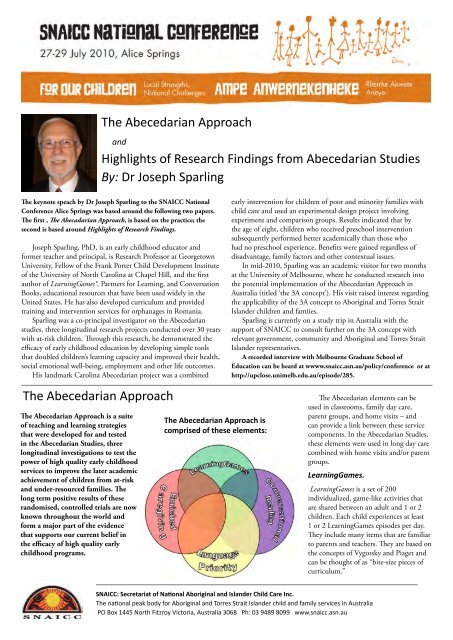
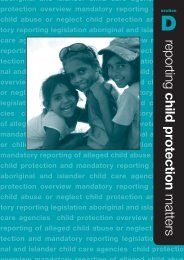

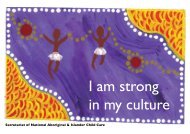
![Kukumbat gudwan daga - really cooking good food. [PDF 716 KB]](https://img.yumpu.com/47617674/1/190x134/kukumbat-gudwan-daga-really-cooking-good-food-pdf-716-kb.jpg?quality=85)
